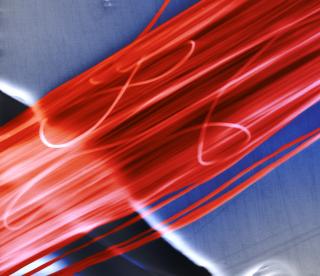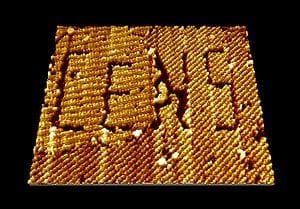
They discovered that by making the nanofiber thinner than had been done before, it became not only stronger, as was expected, but also tougher.
University of Nebraska-Lincoln materials engineers have developed a structural nanofiber that is both strong and tough, a discovery that could transform everything from airplanes and bridges to body armor and bicycles. Their findings are featured on the cover of this week’s April issue of the American Chemical Society‘s journal, ACS Nano.
“Whatever is made of composites can benefit from our nanofibers,” said the team’s leader, Yuris Dzenis, McBroom Professor of Mechanical and Materials Engineering and a member of UNL’s Nebraska Center for Materials and Nanoscience
“Our discovery adds a new material class to the very select current family of materials with demonstrated simultaneously high strength and toughness.”
In structural materials, conventional wisdom holds that strength comes at the expense of toughness. Strength refers to a material’s ability to carry a load. A material’s toughness is the amount of energy needed to break it; so the more a material dents, or deforms in some way, the less likely it is to break. A ceramic plate, for example, can carry dinner to the table, but shatters if dropped, because it lacks toughness. A rubber ball, on the other hand, is easily squished out of shape, but doesn’t break because it’s tough, not strong. Typically, strength and toughness are mutually exclusive.
Dzenis and colleagues developed an exceptionally thin polyacrilonitrile nanofiber, a type of synthetic polymer related to acrylic, using a technique called electrospinning. The process involves applying high voltage to a polymer solution until a small jet of liquid ejects, resulting in a continuous length of nanofiber.
They discovered that by making the nanofiber thinner than had been done before, it became not only stronger, as was expected, but also tougher.
Dzenis suggested that toughness comes from the nanofibers’ low crystallinity. In other words, it has many areas that are structurally unorganized. These amorphous regions allow the molecular chains to slip around more, giving them the ability to absorb more energy.
Most advanced fibers have fewer amorphous regions, so they break relatively easily. In an airplane, which uses many composite materials, an abrupt break could cause a catastrophic crash. To compensate, engineers use more material, which makes airplanes, and other products, heavier.
“If structural materials were tougher, one could make products more lightweight and still be very safe,” Dzenis said.
Body armor, such as bulletproof vests, also requires a material that’s both strong and tough. “To stop the bullet, you need the material to be able to absorb energy before failure, and that’s what our nanofibers will do,” he said.
The Latest Bing News on:
Nanofibers
- Anti-intoxicant gel keeps alcohol out of the bloodstreamon May 13, 2024 at 1:18 pm
If you enjoy having a drink with friends every so often but don't want to get drunk, then a new gel may be just what you're looking for. The ingestible substance is said to help keep alcohol from ...
- Innovative electrospinning method creates advanced ceramic nanofibers and springson May 8, 2024 at 5:00 pm
Electrospinning, which employs electric fields to draw ultrathin fibers from a liquid, has emerged as the leading approach to create ceramic nanofibers. However, the technique requires the starting ...
- Aligned peptide 'noodles' could enable lab-grown biological tissueson May 3, 2024 at 10:18 am
A team of chemists and bioengineers at Rice University and the University of Houston have achieved a significant milestone in their work to create a biomaterial that can be used to grow biological ...
- Nanofibers Industry Poised for Exponential Growth: 26% CAGR Anticipated from 2023 to 2028on May 1, 2024 at 10:02 pm
Nanofibers: Transforming Healthcare and Industries with Biocompatible Breakthroughs, from Tissue Engineering to Drug Delivery. BOSTON, May 2, 2024 /PRNewswire/ -- According to the latest BCC Research ...
- Adequately stabilized and exposed Cu/CuₓO heterojunction on porous carbon nanofiberson April 29, 2024 at 11:14 am
Inexpensive and readily available copper-based catalysts are considered ideal for the electrochemical CO2 reduction reaction (CO2RR) to produce multi-carbon products. The presence of copper oxides is ...
- Nanofibers Rid Water of Hazardous Dyeson April 24, 2024 at 5:00 pm
Using waste to purify water may sound counterintuitive. But at TU Wien, this is exactly what has now been achieved: a special nanostructure has been developed to filter a widespread class of harmful ...
- Nanofibers rid water of hazardous dyeson April 23, 2024 at 5:00 pm
Using waste to purify water may sound counterintuitive. But at TU Wien, this is exactly what has now been achieved: a special nanostructure has been developed to filter a widespread class of ...
- Nanofibers rid water of hazardous dyes: Researchers develop efficient filters based on cellulose wasteon April 23, 2024 at 5:00 pm
Using waste to purify water may sound counterintuitive. But at TU Wien, this is exactly what has now been achieved. Researchers have developed a special nanostructure to filter a widespread class ...
- Nanofibers rid water of hazardous dyeson April 23, 2024 at 5:00 pm
Nanofibers rid water of hazardous dyes Dyes are a major environmental problem. Efficient filters have now been developed -- based on cellulose waste Date: April 24, 2024 Source: Vienna University ...
- The Nanofibers in '3 Body Problem' Are Real, and Yes, They Can Do Thaton March 26, 2024 at 1:33 pm
One of the biggest concepts introduced in 3 Body Problem is the idea of nanotechnology, and, specifically, nanofibers. The Three-Body Problem book's protagonist has this as one of his many skills ...
The Latest Google Headlines on:
Nanofibers
[google_news title=”” keyword=”nanofibers” num_posts=”10″ blurb_length=”0″ show_thumb=”left”] [/vc_column_text]The Latest Bing News on:
Structural nanofiber
- Structural biology articles from across Nature Portfolioon May 8, 2024 at 5:00 pm
Structural biology is the study of the molecular structure and dynamics of biological macromolecules, particularly proteins and nucleic acids, and how alterations in their structures affect their ...
- Researchers develop bioinspired Bouligand structure for enhanced mechanical propertieson May 6, 2024 at 10:33 pm
Bouligand structures, found in natural materials like fish scales, lobster peritoneum and bones, are known for providing exceptional mechanical properties to biomaterials. While progress has been made ...
- USTC develops bioinspired Bouligand structure for enhanced mechanical propertieson May 5, 2024 at 5:00 pm
A research team led by academician YU Shuhong of the University of Science and Technology of China (USTC) of the Chinese Academy of Sciences (CAS) introduced a bioinspired Bouligand structure with a ...
- Adequately stabilized and exposed Cu/CuₓO heterojunction on porous carbon nanofiberson April 29, 2024 at 11:14 am
Inexpensive and readily available copper-based catalysts are considered ideal for the electrochemical CO2 reduction reaction (CO2RR) to produce multi-carbon products. The presence of copper oxides is ...
- Structural materials articles from across Nature Portfolioon April 25, 2024 at 5:00 pm
Structural materials are materials used or studied primarily for their mechanical properties, as opposed to their electronic, magnetic, chemical or optical characteristics. This can include a ...
- Structural Geologyon April 14, 2024 at 11:19 pm
55, Issue. 9, p. 1073. Lavishly illustrated in color, this textbook takes an applied approach to introduce undergraduate students to the basic principles of structural geology. The book provides ...
- What Is The Cost To Hire A Structural Engineer In 2024?on April 13, 2024 at 5:54 pm
A structural engineer inspection costs an average of $900, but the price can range anywhere from $300 to $2,000 depending on the extent of the related reports and drawings. When we include the ...
- Structural Glazing: The Latest Architecture and Newson February 29, 2024 at 4:00 pm
The question, "How can we control natural light in interior spaces?" is fundamental in architecture. Unregulated direct sunlight can cause discomfort such as visual strain and undesirable heat ...
- Introduction to Nanofiber Materialson December 19, 2023 at 11:27 pm
Featuring intensive coverage of electroactive, bioactive and structural nanofibers ... with understandable and clear schematics which are essential to fully understand nanofiber formation and their ...
- MSc Structural Engineering / Overviewon October 24, 2023 at 5:05 am
As there is high demand for this course we operate a staged admissions process with selection deadlines throughout the year. Please find more information in our Application and Selection section. All ...
The Latest Google Headlines on:
Structural nanofiber
[google_news title=”” keyword=”structural nanofiber” num_posts=”10″ blurb_length=”0″ show_thumb=”left”]











